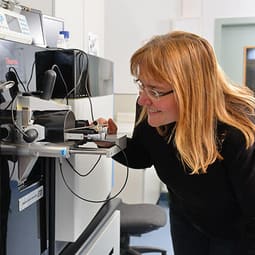
Andrea Sinz
Full Professor, Department of Pharmaceutical Chemistry and Bioanalytics, Martin Luther University Halle-Wittenberg, Germany
False

Full Professor, Department of Pharmaceutical Chemistry and Bioanalytics, Martin Luther University Halle-Wittenberg, Germany
Passion: Introducing people to the field of mass spectrometry – and the fact you can get answers to (almost) every chemical, biochemical or pharmacological question using this technique.
Pivotal moment: One pivotal moment in my career was when I was introduced to protein mass spectrometry – something that happened just by chance as two mass spectrometers (an ESI ion trap and a MALDI-TOF instrument) were sitting in the lab and someone was needed to operate them. My research project dealt with the structural characterization of muscle proteins by chemical cross-linking and mass spectrometry. At that time, the mass spectrometers were not really up to meeting the challenges of analyzing such complex mixtures. But for me, it became a fascinating goal to develop the cross-linking/mass spectrometry approach as a general method for protein structure characterization. Another pivotal moment was that a unique opportunity opened up for me at the University of Leipzig, where I was given the chance to establish my own independent junior research group based on the use of an FTICR mass spectrometer. This suddenly paved the way for me to pursue my own ideas. But I could never have achieved my goals without ambitious and creative students – and these days, the points at which these students join my lab prove to be the most pivotal moments in my career.
Prediction: It is obvious that cryo-electron microscopy will change the field of protein structure analysis. But luckily, mass spectrometric techniques, such as native MS and cross-linking/MS, will continue to make valuable contributions.
Receive the latest analytical scientist news, personalities, education, and career development – weekly to your inbox.

False
False
False